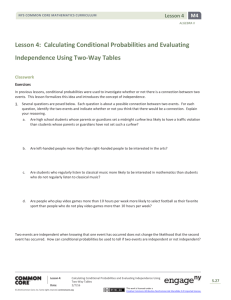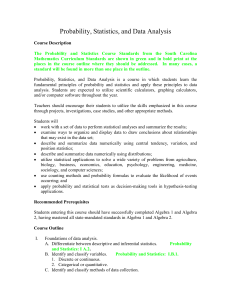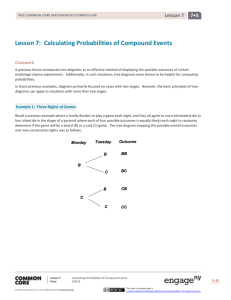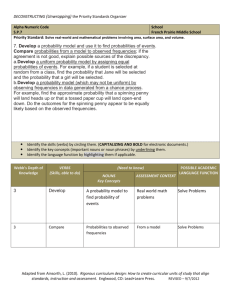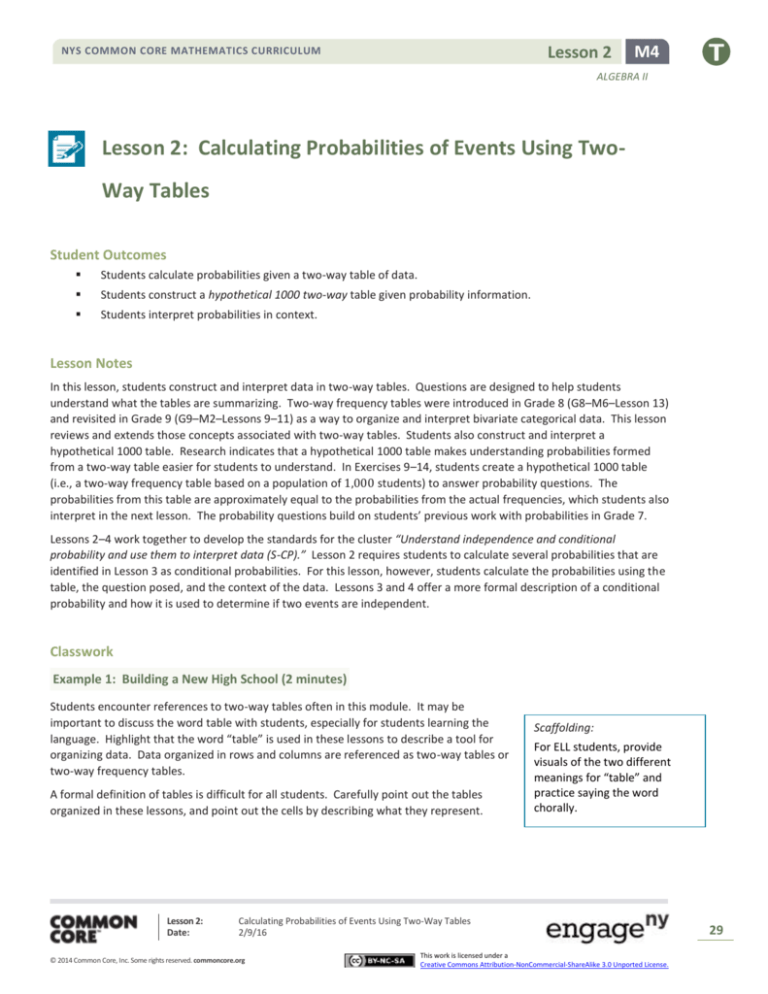
Lesson 2
NYS COMMON CORE MATHEMATICS CURRICULUM
M4
ALGEBRA II
Lesson 2: Calculating Probabilities of Events Using TwoWay Tables
Student Outcomes
Students calculate probabilities given a two-way table of data.
Students construct a hypothetical 1000 two-way table given probability information.
Students interpret probabilities in context.
Lesson Notes
In this lesson, students construct and interpret data in two-way tables. Questions are designed to help students
understand what the tables are summarizing. Two-way frequency tables were introduced in Grade 8 (G8–M6–Lesson 13)
and revisited in Grade 9 (G9–M2–Lessons 9–11) as a way to organize and interpret bivariate categorical data. This lesson
reviews and extends those concepts associated with two-way tables. Students also construct and interpret a
hypothetical 1000 table. Research indicates that a hypothetical 1000 table makes understanding probabilities formed
from a two-way table easier for students to understand. In Exercises 9–14, students create a hypothetical 1000 table
(i.e., a two-way frequency table based on a population of 1,000 students) to answer probability questions. The
probabilities from this table are approximately equal to the probabilities from the actual frequencies, which students also
interpret in the next lesson. The probability questions build on students’ previous work with probabilities in Grade 7.
Lessons 2–4 work together to develop the standards for the cluster “Understand independence and conditional
probability and use them to interpret data (S-CP).” Lesson 2 requires students to calculate several probabilities that are
identified in Lesson 3 as conditional probabilities. For this lesson, however, students calculate the probabilities using the
table, the question posed, and the context of the data. Lessons 3 and 4 offer a more formal description of a conditional
probability and how it is used to determine if two events are independent.
Classwork
Example 1: Building a New High School (2 minutes)
Students encounter references to two-way tables often in this module. It may be
important to discuss the word table with students, especially for students learning the
language. Highlight that the word “table” is used in these lessons to describe a tool for
organizing data. Data organized in rows and columns are referenced as two-way tables or
two-way frequency tables.
A formal definition of tables is difficult for all students. Carefully point out the tables
organized in these lessons, and point out the cells by describing what they represent.
Lesson 2:
Date:
Scaffolding:
For ELL students, provide
visuals of the two different
meanings for “table” and
practice saying the word
chorally.
Calculating Probabilities of Events Using Two-Way Tables
2/9/16
© 2014 Common Core, Inc. Some rights reserved. commoncore.org
This work is licensed under a
Creative Commons Attribution-NonCommercial-ShareAlike 3.0 Unported License.
29
Lesson 2
NYS COMMON CORE MATHEMATICS CURRICULUM
M4
ALGEBRA II
Example 1: Building a New High School
The School Board of Waldo, a rural town in the Midwest, is considering building a new high school
primarily funded by local taxes. They decided to interview eligible voters to determine if the
school board should build a new high school facility to replace the current high school building.
There is only one high school in the town. Every registered voter in Waldo was interviewed. In
addition to asking about support for a new high school, data on gender and age group were also
recorded. The data from these interviews are summarized below.
Yes
Age (in years)
𝟏𝟖–𝟐𝟓
𝟐𝟔–𝟒𝟎
𝟒𝟏–𝟔𝟓
𝟔𝟔 and older
Male
𝟐𝟗
𝟓𝟑
𝟑𝟎
𝟕
Should our town build a new high school?
No
No answer
Female
Male
Female
Male
Female
𝟑𝟐
𝟖
𝟔
𝟎
𝟎
𝟔𝟎
𝟒𝟎
𝟒𝟒
𝟐
𝟒
𝟑𝟔
𝟒𝟒
𝟑𝟓
𝟐
𝟐
𝟐𝟔
𝟐𝟒
𝟐𝟗
𝟐
𝟎
Scaffolding:
Consider using the following
example to help students
understand how to build and
interpret a two-way table. If
needed, G8–M6–Lesson 13 in
can be used for remediation.
In a class of 20 students, 5
boys and 7 girls like chocolate
ice cream. Six boys like vanilla
ice cream.
What are the variables?
How could we organize
the variables in the
following table?
Exercises 1–8: Building a New High School (15–20 minutes)
The following exercises ask students to interpret the data summarized in the table. The
MP.2 exercises allow students to reason abstractly by making summaries based on data. Discuss
how the data summaries are being used to answer each question. Although the questions
ask students to predict, the word “probability” is not always used in the questions. This is
intentional, as it helps students to revisit their previous work with probability. As you
work with students, emphasize the goal of predicting outcomes based on the data.
Boys
Girls
Chocolate
𝟓
𝟕
Vanilla
𝟔
What does the missing cell
represent? How can you
determine the missing
value?
Allow students to work in small groups as they answer the following questions. Select
questions to discuss as a whole group based on student work. Allow students to use a calculator. For these questions, a
scientific calculator is sufficient.
Exercises 1–8
1.
Based on this survey, do you think the school board should recommend building a new high school? Explain your
answer.
𝟐𝟕𝟑 out of the 𝟓𝟏𝟓 eligible voters (or approximately 𝟓𝟑%) indicated “Yes.” As a result, I think the voters will
recommend building a new high school.
2.
An eligible voter is picked at random. If this person is 𝟐𝟏 years old, do you think he or she would indicate that the
town should build a high school? Why or why not?
Most of the eligible voters ages 𝟏𝟖–𝟐𝟓 indicated “Yes.” 𝟔𝟏 of the 𝟕𝟓 eligible voters in this age group indicated
“Yes.” I would predict a 𝟐𝟏-year-old in this age group to have answered “Yes.”
3.
An eligible voter is picked at random. If this person is 𝟓𝟓 years old, do you think he or she would indicate that the
town should build a high school? Why or why not?
Most of the eligible voters ages 𝟒𝟏–𝟔𝟓 indicated “No” to the question about building a high school. I would predict
that a person in this age group would indicate that the town should not build a high school.
Lesson 2:
Date:
Calculating Probabilities of Events Using Two-Way Tables
2/9/16
© 2014 Common Core, Inc. Some rights reserved. commoncore.org
This work is licensed under a
Creative Commons Attribution-NonCommercial-ShareAlike 3.0 Unported License.
30
Lesson 2
NYS COMMON CORE MATHEMATICS CURRICULUM
M4
ALGEBRA II
4.
The School Board wondered if the probability of recommending a new high school was different for different age
categories. Why do you think the survey classified voters using the age categories 𝟏𝟖–𝟐𝟓 years old, 𝟐𝟔–𝟒𝟎 years
old, 𝟒𝟏–𝟔𝟓 years old, and 𝟔𝟔 years old and older?
The age groups used in the table represent people with different interests or opinions regarding the building of a
new high school. For example, people ages 𝟐𝟔–𝟒𝟎 are more likely to have children in school than people in the
other age groups. The probability that a person in each of these age categories would recommend building a new
high school might vary.
5.
It might be helpful to organize the data in a two-way frequency table. Use the given data to complete the following
two-way frequency table. Note that the age categories are represented as rows, and the possible responses are
represented as columns.
Completed table:
𝟏𝟖 – 𝟐𝟓 years old
𝟐𝟔 – 𝟒𝟎 years old
𝟒𝟏 – 𝟔𝟓 years old
𝟔𝟔 years old and older
Total
Yes
𝟔𝟏
𝟏𝟏𝟑
𝟔𝟔
𝟑𝟑
𝟐𝟕𝟑
No
𝟏𝟒
𝟖𝟒
𝟕𝟗
𝟓𝟑
𝟐𝟑𝟎
No answer
𝟎
𝟔
𝟒
𝟐
𝟏𝟐
Total
𝟕𝟓
𝟐𝟎𝟑
𝟏𝟒𝟗
𝟖𝟖
𝟓𝟏𝟓
Note: Exercise 6 challenges students to think about a “headline summary” of data (something they may encounter in a
newspaper, blog, or news report). Discuss how these types of short summaries of data need to be examined by readers.
The exercise provides an opportunity for students to form their own conclusions from the data and to reconcile their
MP.3 conclusions with summaries expressed in the form of headlines. In this way, students are also critiquing the reasoning of
others.
6.
A local news service plans to write an article summarizing the survey results. Three possible headlines for this
article are provided below. Is each headline accurate or inaccurate? Support your answer using probabilities
calculated using the table above.
Headline 1: Waldo Voters Likely to Support Building a New High School
Yes, this accurate. 𝟐𝟕𝟑 out of 𝟓𝟏𝟓, or approximately 𝟎. 𝟓𝟑𝟎 (or 𝟓𝟑. 𝟎%), support building a new school. The
probability that an eligible voter would vote “Yes” is greater than 𝟎. 𝟓𝟎, so you would think it is likely that voters will
support building a new high school.
Headline 2: Older Voters Less Likely to Support Building a New High School
Yes, this headline is accurate. If you define older voters as 𝟒𝟏 or older, then 𝟏𝟑𝟐 out of 𝟐𝟑𝟕 voters 𝟒𝟏 or older, or
approximately 𝟎. 𝟓𝟓𝟕 (or approximately 𝟓𝟓. 𝟕%), indicated they would not support building a new high school.
Headline 3: Younger Voters Not Interested in Building a New High School
This headline is not accurate. 𝟔𝟏 out of 𝟕𝟓 eligible voters, or approximately 𝟎. 𝟖𝟏𝟑 (or 𝟖𝟏. 𝟑%) representing the
youngest eligible voters, indicated “Yes” to building a new high school.
Note: Exercise 7 is challenging. Students are expected to use both the probability of voting “yes” and the new
information about the number of eligible voters expected to vote to answer this question. It may be necessary to help
some students develop the final answer by working through a specific age group before they combine all age groups.
Consider tackling this question as a whole group. This question also presents another opportunity to discuss the role of
Lesson 2:
Date:
Calculating Probabilities of Events Using Two-Way Tables
2/9/16
© 2014 Common Core, Inc. Some rights reserved. commoncore.org
This work is licensed under a
Creative Commons Attribution-NonCommercial-ShareAlike 3.0 Unported License.
31
Lesson 2
NYS COMMON CORE MATHEMATICS CURRICULUM
M4
ALGEBRA II
probability. Students previously indicated that most voters would vote “yes” to building a new high school. This
question will raise the possibility that voters will vote “no” by adding information about past voter turnout.
7.
The School Board decided to put the decision on whether or not to build the high school up for a referendum in the
next election. At the last referendum regarding this issue, only 𝟐𝟓 of the eligible voters ages 𝟏𝟖–𝟐𝟓 voted, 𝟏𝟏𝟎 of
the eligible voters ages 𝟐𝟔–𝟒𝟎 voted, 𝟏𝟑𝟎 of the eligible voters ages 𝟒𝟏–𝟔𝟓 voted, and 𝟖𝟎 of the eligible voters
ages 𝟔𝟔 and older voted. If the voters in the next election turnout in similar numbers, do you think this referendum
will pass? Justify your answer.
Use the probabilities that a voter from an age group would vote “Yes.” Multiply the probabilities that a person
would vote “Yes” by the number of people estimated to vote in each age category:
𝟐𝟓(𝟎. 𝟖𝟏𝟑) + 𝟏𝟏𝟎(𝟎. 𝟓𝟓𝟕) + 𝟏𝟑𝟎(𝟎. 𝟒𝟒𝟐) + 𝟖𝟎(𝟎. 𝟑𝟕𝟓) is approximately 𝟏𝟔𝟗.
𝟏𝟔𝟗 out of the estimated 𝟑𝟒𝟓 voters will vote “Yes.” Since this is less than half, we would predict that the vote will
indicate the high school should not be built.
8.
Is it possible that your prediction of the election outcome might be incorrect? Explain.
Yes. The above is only a prediction. The actual results could be different. It depends on the actual voter turnout and
whether people actually vote as they indicated in the survey.
Example 2: Smoking and Asthma (2 minutes)
Read through the example as a class.
Example 2
Health officials in Milwaukee, Wisconsin were concerned about teenagers with asthma. People with asthma often have
difficulty with normal breathing. In a local research study, researchers collected data on the incidence of asthma among
students enrolled in a Milwaukee Public High School.
Students in the high school completed a survey that was used to begin this research. Based on this survey, the probability
of a randomly selected student at this high school having asthma was found to be 𝟎. 𝟏𝟗𝟑. Students were also asked if
they had at least one family member living in their house who smoked. The probability of a randomly selected student
having at least one member in their household who smoked was reported to be 𝟎. 𝟒𝟐𝟏.
Exercises 9–14 (10–15 minutes)
Make sure students understand how the information will be organized in the given table.
If necessary, point to a cell in the table and ask students to describe what this cell
represents in the context of the data.
This scenario will be revisited in Lesson 4, where students will explore the relationship
between having asthma and having at least one family member who smokes.
Scaffolding:
Consider challenging advanced
learners to build the
hypothetical table
independently or with a
neighbor.
Allow students to continue to work in small groups as they answer the following
questions.
Lesson 2:
Date:
Calculating Probabilities of Events Using Two-Way Tables
2/9/16
© 2014 Common Core, Inc. Some rights reserved. commoncore.org
This work is licensed under a
Creative Commons Attribution-NonCommercial-ShareAlike 3.0 Unported License.
32
Lesson 2
NYS COMMON CORE MATHEMATICS CURRICULUM
M4
ALGEBRA II
Exercises 9–14
It would be easy to calculate probabilities if the data for the students had been organized into a two-way table like the
one used in Exercise 5. But there is no table here, only probability information. One way around this is to think about
what the table might have been if there had been 𝟏, 𝟎𝟎𝟎 students at the school when the survey was given. This table is
called a hypothetical 1000 two-way table.
What if the population of students at this high school was 𝟏, 𝟎𝟎𝟎? The population was probably not exactly 𝟏, 𝟎𝟎𝟎
students, but using an estimate of 𝟏, 𝟎𝟎𝟎 students provides an easier way to understand the given probabilities.
Connecting these estimates to the actual population is completed in a later exercise. Place the value of 𝟏, 𝟎𝟎𝟎 in the cell
representing the total population. Based on a hypothetical 1000 population, consider the following table.
No household
member smokes
At least one household
member smokes
Total
Cell 𝟏
Cell 𝟐
Cell 𝟑
Cell 𝟒
Cell 𝟓
Cell 𝟔
Cell 𝟕
Cell 𝟖
𝟏, 𝟎𝟎𝟎
Student indicates he or she
has asthma
Student indicates he or she
does not have asthma
Total
9.
The probability that a randomly selected student at this high school has asthma is 𝟎. 𝟏𝟗𝟑. This probability can be
used to calculate the value of one of the cells in the table above. Which cell is connected to this probability? Use
this probability to calculate the value of that cell.
Cell 𝟑. The value for this cell would be 𝟏𝟗𝟑 students.
10. The probability that a randomly selected student has at least 𝟏 household member who smokes is 𝟎. 𝟒𝟐𝟏. Which
cell is connected to this probability? Use this probability to calculate the value of that cell.
Cell 𝟖. The value for this cell would be 𝟒𝟐𝟏 students.
11. In addition to the previously given probabilities, the probability that a randomly selected student has at least one
household member who smokes and has asthma is 𝟎. 𝟏𝟐𝟎. Which cell is connected to this probability? Use this
probability to calculate the value of that cell.
Cell 𝟐. The value for this cell would be 𝟏𝟐𝟎 students.
12. Complete the two-way frequency table above by calculating the values of the other cells in the table.
The following is a complete table.
Student indicates he or she
has asthma
Student indicates he or she
does not have asthma
Total
Lesson 2:
Date:
No household
member smokes
At least one
household member
smokes
Total
𝟕𝟑
𝟏𝟐𝟎
𝟏𝟗𝟑
𝟓𝟎𝟔
𝟑𝟎𝟏
𝟖𝟎𝟕
𝟓𝟕𝟗
𝟒𝟐𝟏
𝟏, 𝟎𝟎𝟎
Calculating Probabilities of Events Using Two-Way Tables
2/9/16
© 2014 Common Core, Inc. Some rights reserved. commoncore.org
This work is licensed under a
Creative Commons Attribution-NonCommercial-ShareAlike 3.0 Unported License.
33
Lesson 2
NYS COMMON CORE MATHEMATICS CURRICULUM
M4
ALGEBRA II
13. Based on your completed two-way table, estimate the following probabilities as a fraction and also as a decimal
(rounded to three decimal places):
a.
A randomly selected student has asthma. What is the probability this student has at least 𝟏 household
member who smokes?
The probability is
b.
𝟏𝟗𝟑
or approximately 𝟎. 𝟔𝟐𝟐.
A randomly selected student does not have asthma. What is the probability he or she has at least one
household member who smokes?
The probability is
c.
𝟏𝟐𝟎
𝟑𝟎𝟏
𝟖𝟎𝟕
or approximately 𝟎. 𝟑𝟕𝟑.
A randomly selected student has at least one household member who smokes. What is the probability this
student has asthma?
The probability is
𝟏𝟐𝟎
𝟒𝟐𝟏
or approximately 𝟎. 𝟐𝟖𝟓.
14. Do you think that whether or not a student has asthma is related to whether or not this student has at least one
family member who smokes? Explain your answer.
Yes. The probability a student with asthma has a household member who smokes is noticeably greater than the
probability a student who does not have asthma has a household member who smokes.
Closing (5 minutes)
What was the role of probability in our two examples?
To use data to predict outcomes of events, such as selecting a voter who will vote “yes” or selecting a
student who has asthma and at least one household member who smoke.
As you used probabilities to make predictions, did you learn anything about the context of the data?
Answers will vary. Anticipate that students indicate that younger voters were less likely to vote or that
older voters in Waldo were less likely to support the new high school or that students with asthma were
more likely to have a household family member who smokes. Emphasize that probabilities must be
interpreted in context.
Ask students to summarize the main ideas of the lesson in writing or with a neighbor. Use this as an opportunity to
informally assess comprehension of the lesson. The Lesson Summary below offers some important ideas that should be
included.
Lesson Summary
Data organized in a two-way frequency table can be used to calculate probabilities.
In certain problems, probabilities that are known can be used to create a hypothetical 1000 two-way table. The
hypothetical population of 𝟏, 𝟎𝟎𝟎 can then be used to calculate probabilities.
Probabilities are always interpreted in context.
Exit Ticket (5 minutes)
Lesson 2:
Date:
Calculating Probabilities of Events Using Two-Way Tables
2/9/16
© 2014 Common Core, Inc. Some rights reserved. commoncore.org
This work is licensed under a
Creative Commons Attribution-NonCommercial-ShareAlike 3.0 Unported License.
34
Lesson 2
NYS COMMON CORE MATHEMATICS CURRICULUM
M4
ALGEBRA II
Name
Date
Lesson 2: Calculating Probabilities of Events Using Two-Way
Tables
Exit Ticket
Did males and females respond similarly to the survey question about building a new high school? Recall the original
summary of the data:
Should our town build a new high school?
Yes
No
No answer
Male Female
Male Female Male Female
29
32
8
6
0
0
53
60
40
44
2
4
30
36
44
35
2
2
7
26
24
29
2
0
Age (in years)
18–25
26–40
41–65
66 and older
1.
Complete the following two-way frequency table:
Yes
119
Male
Female
Total
2.
No
230
No
answer
6
12
Total
515
Use the above two-way frequency table to answer the following questions:
a.
If a randomly selected eligible voter is a female, what is the probability she will vote to build a new high
school?
b.
If a randomly selected eligible voter is male, what is the probability he will vote to build a new high school?
Lesson 2:
Date:
Calculating Probabilities of Events Using Two-Way Tables
2/9/16
© 2014 Common Core, Inc. Some rights reserved. commoncore.org
This work is licensed under a
Creative Commons Attribution-NonCommercial-ShareAlike 3.0 Unported License.
35
Lesson 2
NYS COMMON CORE MATHEMATICS CURRICULUM
M4
ALGEBRA II
3.
An automobile company has two factories assembling its luxury cars. The company is interested in whether
consumers rate cars produced at one factory more highly than cars produced at the other factory. Factory A
assembles 60% of the cars. A recent survey indicated that 70% of the cars made by this company (both factories
combined) were highly rated. This same survey indicated that 10% of all cars made by this company were both
made at Factory B and were not highly rated.
a.
Create a hypothetical 1000 two-way table based on the results of this survey by filling in the table below.
Car was highly rated
by consumers
Car was not highly
rated by consumers
Total
Factory A
Factory B
Total
b.
A randomly selected car was assembled in Factory B. What is the probability this car is highly rated?
Lesson 2:
Date:
Calculating Probabilities of Events Using Two-Way Tables
2/9/16
© 2014 Common Core, Inc. Some rights reserved. commoncore.org
This work is licensed under a
Creative Commons Attribution-NonCommercial-ShareAlike 3.0 Unported License.
36
Lesson 2
NYS COMMON CORE MATHEMATICS CURRICULUM
M4
ALGEBRA II
Exit Ticket Sample Solutions
Did males and females respond similarly to the survey question about building a new high school? Recall the original
summary of the data:
Yes
Age (in years)
𝟏𝟖–𝟐𝟓
𝟐𝟔–𝟒𝟎
𝟒𝟏–𝟔𝟓
𝟔𝟔 and older
1.
Male
𝟐𝟗
𝟓𝟑
𝟑𝟎
𝟕
Complete the following two-way frequency table:
Yes
𝟏𝟏𝟗
𝟏𝟓𝟒
𝟐𝟕𝟑
Male
Female
Total
2.
No
𝟏𝟏𝟔
𝟏𝟏𝟒
𝟐𝟑𝟎
No answer
𝟔
𝟔
𝟏𝟐
Total
𝟐𝟒𝟏
𝟐𝟕𝟒
𝟓𝟏𝟓
Use the above two-way frequency table to answer the following questions:
a.
If a randomly selected eligible voter is a female, what is the probability she will vote to build a new high
school?
𝟏𝟓𝟒
𝟐𝟕𝟒
b.
or approximately 𝟎. 𝟓𝟔𝟐.
If a randomly selected eligible voter is male, what is the probability he will vote to build a new high school?
𝟏𝟏𝟗
𝟐𝟒𝟏
3.
Should our town build a new high school?
No
No answer
Female
Male
Female
Male
Female
𝟑𝟐
𝟖
𝟔
𝟎
𝟎
𝟔𝟎
𝟒𝟎
𝟒𝟒
𝟐
𝟒
𝟑𝟔
𝟒𝟒
𝟑𝟓
𝟐
𝟐
𝟐𝟔
𝟐𝟒
𝟐𝟗
𝟐
𝟎
or approximately 𝟎. 𝟒𝟗𝟒.
An automobile company has two factories assembling its luxury cars. The company is interested in whether
consumers rate cars produced at one factory more highly than cars produced at the other factory. Factory A
assembles 𝟔𝟎% of the cars. A recent survey indicated that 𝟕𝟎% of the cars made by this company (both factories
combined) were highly rated. This same survey indicated that 𝟏𝟎% of all cars made by this company were both
made at Factory B and were not highly rated.
a.
Create a hypothetical 1000 two-way table based on the results of this survey by filling in the table below.
Car was highly rated
by consumers
𝟒𝟎𝟎
𝟑𝟎𝟎
𝟕𝟎𝟎
Factory A
Factory B
Total
b.
Car was not highly rated
by consumers
𝟐𝟎𝟎
𝟏𝟎𝟎
𝟑𝟎𝟎
Total
𝟔𝟎𝟎
𝟒𝟎𝟎
𝟏, 𝟎𝟎𝟎
A randomly selected car was assembled in Factory B. What is the probability this car is highly rated?
The probability a car from Factory B is highly rated is
Lesson 2:
Date:
𝟑𝟎𝟎
𝟒𝟎𝟎
or 𝟎. 𝟕𝟓𝟎.
Calculating Probabilities of Events Using Two-Way Tables
2/9/16
© 2014 Common Core, Inc. Some rights reserved. commoncore.org
This work is licensed under a
Creative Commons Attribution-NonCommercial-ShareAlike 3.0 Unported License.
37
Lesson 2
NYS COMMON CORE MATHEMATICS CURRICULUM
M4
ALGEBRA II
Problem Set Sample Solutions
1.
The Waldo School Board asked eligible voters to evaluate the town’s library service. Data are summarized in the
following table.
Age (in years)
18 – 25
26 – 40
41-65
66 and older
a.
How would you rate our town’s library services?
Average
Poor
Male
Female
Male
Female
𝟓
𝟕
𝟓
𝟓
𝟐𝟓
𝟑𝟎
𝟐𝟎
𝟑𝟎
𝟐𝟔
𝟐𝟏
𝟏𝟓
𝟏𝟎
𝟖
𝟏𝟓
𝟐
𝟏𝟎
Do not use library
Male
Female
𝟏𝟕
𝟏𝟖
𝟐𝟎
𝟐𝟎
𝟓
𝟏𝟎
𝟐
𝟓
What is the probability that a randomly selected person who completed the survey rated the library as
“good?”
𝟏𝟖𝟒
𝟓𝟏𝟓
b.
Male
𝟏𝟎
𝟑𝟎
𝟑𝟎
𝟐𝟏
Good
Female
𝟖
𝟐𝟖
𝟑𝟐
𝟐𝟓
or 𝟎. 𝟑𝟓𝟕
Imagine talking to a randomly selected male who had completed the survey. How do you think this person
rated the library services? Explain your answer.
Answers will vary. A general look at the table indicates that most males rated the library as “Good.” As a
result, I would predict that this person would rate the library as “Good.”
c.
Use the given data to construct a two-way table that summarizes the responses on gender and rating of the
library services. Use the following template as your guide.
Good
𝟗𝟏
𝟗𝟑
𝟏𝟖𝟒
Male
Female
Total
d.
Poor
𝟒𝟐
𝟓𝟓
𝟗𝟕
Do Not Use
𝟒𝟒
𝟓𝟑
𝟗𝟕
Total
𝟐𝟒𝟏
𝟐𝟕𝟒
𝟓𝟏𝟓
Based on your table, answer the following:
i.
A randomly selected person who completed the survey is male. What is the probability he rates the
library services as “good?”
𝟗𝟏
𝟐𝟒𝟏
ii.
or approximately 𝟎. 𝟑𝟕𝟖.
A randomly selected person who completed the survey is female. What is the probability she rates the
library services as “good?”
𝟗𝟑
𝟐𝟕𝟒
e.
Average
𝟔𝟒
𝟕𝟑
𝟏𝟑𝟕
or approximately 𝟎. 𝟑𝟑𝟗.
Also based on your table, answer the following.
i.
A randomly selected person who completed the survey rated the library services as “good.” What is
the probability this person is a male?
𝟗𝟏
𝟏𝟖𝟒
or approximately 𝟎. 𝟒𝟗𝟓.
Lesson 2:
Date:
Calculating Probabilities of Events Using Two-Way Tables
2/9/16
© 2014 Common Core, Inc. Some rights reserved. commoncore.org
This work is licensed under a
Creative Commons Attribution-NonCommercial-ShareAlike 3.0 Unported License.
38
Lesson 2
NYS COMMON CORE MATHEMATICS CURRICULUM
M4
ALGEBRA II
ii.
A randomly selected person who completed the survey rated the library services as “good.” What is
the probability this person is a female?
𝟗𝟑
𝟐𝟕𝟒
f.
or approximately 𝟎. 𝟑𝟑𝟗.
Do you think there is a difference in how males and females rated library services? Explain your answer.
Answers will vary. Yes. For example, 𝟑𝟕. 𝟗% of the males rated the library services as good, but only 𝟑𝟑. 𝟗%
of the females rated the services this way. There are also differences between males and females for the
other rating categories.
2.
Obedience School for Dogs is a small franchise that offers obedience classes for dogs. Some people think that larger
dogs are easier to train and, therefore, should not be charged as much for the classes. To investigate this claim,
dogs enrolled in the classes were classified as large (𝟑𝟎 pounds or more) or small (under 𝟑𝟎 pounds). The dogs were
also classified by whether or not they passed the obedience class offered by the franchise. 𝟒𝟓% of the dogs
involved in the classes were large. 𝟔𝟎% of the dogs passed the class. Records indicate that 𝟒𝟎% of the dogs in the
classes were small and passed the course.
a.
Complete the following hypothetical 1000 two-way table.
Passed the course
𝟐𝟎𝟎
𝟒𝟎𝟎
𝟔𝟎𝟎
Large Dogs
Small Dogs
Total
b.
𝟔𝟎𝟎
𝟒𝟓𝟎
or approximately 𝟎. 𝟒𝟒𝟒, meaning that approximately 𝟒𝟒. 𝟒% of large dogs passed the course.
A dog was randomly selected from the dogs that completed the class. If the selected dog is a small dog, what
is the probability this dog passed the course?
𝟒𝟎𝟎
𝟓𝟓𝟎
e.
or 𝟎. 𝟔𝟎𝟎, meaning 𝟔𝟎% passed the course.
A dog was randomly selected from the dogs that completed the class. If the selected dog was a large dog,
what is the probability this dog passed the course?
𝟐𝟎𝟎
d.
Total
𝟒𝟓𝟎
𝟓𝟓𝟎
𝟏, 𝟎𝟎𝟎
Estimate the probability that a dog selected at random from those enrolled in the classes passed the course.
𝟏,𝟎𝟎𝟎
c.
Did not pass the course
𝟐𝟓𝟎
𝟏𝟓𝟎
𝟒𝟎𝟎
or approximately 𝟎. 𝟕𝟐𝟕, meaning that approximately 𝟕𝟐. 𝟕% of small dogs passed the course.
Do you think dog size and whether or not a dog passes the course are related?
Answers will vary. Yes, there is a noticeably greater probability that a dog passed the obedience class if a dog
is small than if the dog is large.
f.
Do you think large dogs should get a discount? Explain your answer.
Answers will vary. No. Large dogs are not as likely to have passed the obedience class as small dogs.
Lesson 2:
Date:
Calculating Probabilities of Events Using Two-Way Tables
2/9/16
© 2014 Common Core, Inc. Some rights reserved. commoncore.org
This work is licensed under a
Creative Commons Attribution-NonCommercial-ShareAlike 3.0 Unported License.
39


